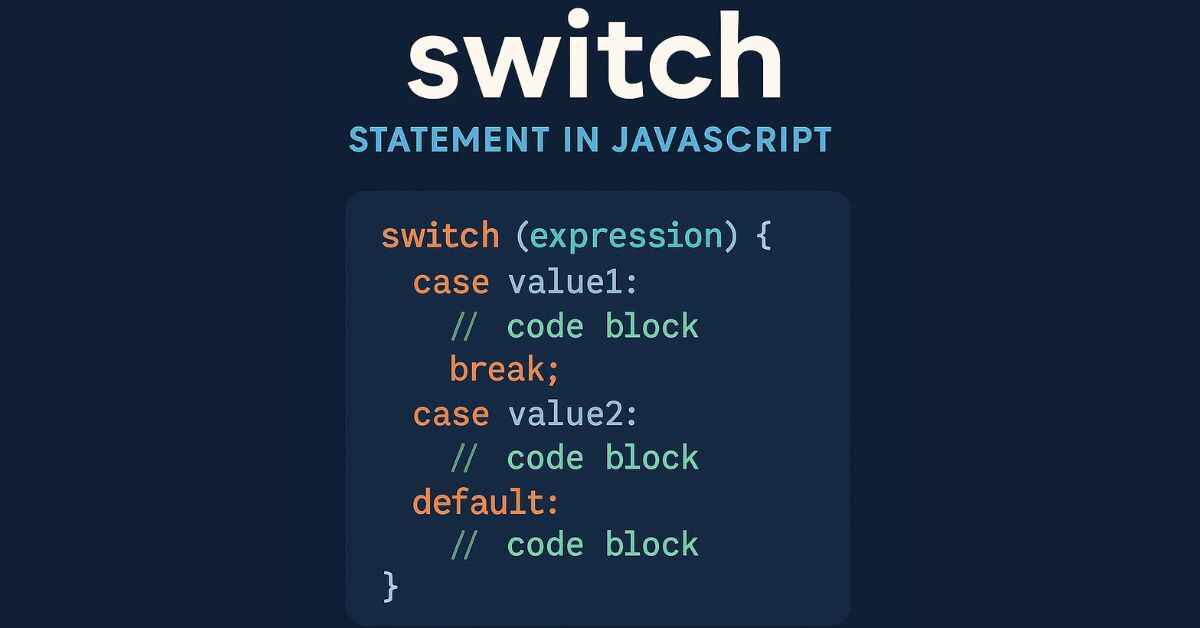|
Getting your Trinity Audio player ready... |
Originally published on Makemychance.com
When writing conditional logic in JavaScript, most developers turn to if...else. But what if you’re checking multiple values against the same variable? That’s where the switch statement shines.
The switch statement offers a clean, readable alternative to complex if...else chains — especially when you’re evaluating the same expression against multiple possible cases.
In this article, you’ll learn:
- What a
switchstatement is - How to use it with examples
- When to use
switchvs.if...else - Common pitfalls and tips

🔁 What is a switch Statement?
The switch statement evaluates an expression and matches it against multiple case clauses. It executes the first matching case and stops at the first break.
🔤 Syntax:
switch (expression) {
case value1:
// code block
break;
case value2:
// code block
break;
default:
// code block
}
✅ Basic Example
const day = 'Wednesday';
switch (day) {
case 'Monday':
console.log('Start of the week');
break;
case 'Wednesday':
console.log('Midweek');
break;
case 'Friday':
console.log('Weekend is coming!');
break;
default:
console.log('It’s just another day');
}
🟢 Output:
MidweekHere, JavaScript compares the value of day with each case. When it matches 'Wednesday', that block executes.
🚨 Why Use break?
Without break, JavaScript will continue executing all subsequent cases (called “fall-through”).
Example without break:
const color = 'green';
switch (color) {
case 'red':
console.log('Red');
case 'green':
console.log('Green');
case 'blue':
console.log('Blue');
default:
console.log('Unknown color');
}
🟠 Output:
Green
Blue
Unknown color
⚠️ That’s likely not what you want, so always use break unless fall-through is intentional.
🔁 Using Multiple Cases for One Result
const fruit = 'apple';
switch (fruit) {
case 'apple':
case 'banana':
case 'mango':
console.log('It’s a fruit!');
break;
default:
console.log('Not sure what it is');
}
This is cleaner than using multiple if conditions.
🧠 switch vs. if...else
Use switch when… | Use if...else when… |
|---|---|
| You’re comparing the same variable | You have multiple different conditions |
| You want cleaner, organized structure | Conditions are complex expressions |
| Performance and readability matter | You have range checks or booleans |
💡 Tips & Best Practices
- Always use
breakunless you’re intentionally using fall-through - Use
defaultto handle unmatched cases - Works best with discrete values, not ranges
- Prefer
if...elsefor numeric range checks or logical expressions
📚 Real-World Use Case: HTTP Status Codes
const status = 404;
switch (status) {
case 200:
console.log('Success');
break;
case 404:
console.log('Page Not Found');
break;
case 500:
console.log('Server Error');
break;
default:
console.log('Unknown Status');
}
✅ Conclusion
The switch statement is a simple yet powerful control structure for comparing one value against many possibilities. It improves readability, avoids repetitive if blocks, and makes your logic easy to maintain.
Next time you find yourself writing multiple if...else blocks comparing the same variable — try switching it up with switch.
📌 Want to learn more JavaScript essentials? Visit Makemychance.com for beginner-to-pro coding tutorials, interview prep, and practical project ideas.
FAQ
What is a switch statement in JavaScript?
The switch statement evaluates an expression and matches it against multiple case clauses. It executes the first matching case and stops at the first break.
How does the syntax of a switch statement look?
The syntax of a switch statement involves specifying the expression to evaluate within parentheses, followed by multiple case clauses, each ending with a break, and an optional default clause for unmatched cases.
Why is the break statement important in a switch?
The break statement prevents JavaScript from executing all subsequent cases after a match, known as fall-through. Omitting break leads to the execution of all following case blocks, which is usually undesirable unless fall-through behavior is intended.
How can multiple cases yield the same result in a switch statement?
Different case statements can be grouped together without a break between them so they execute the same block of code, allowing multiple values to produce a single output or action.
When should I prefer switch over if…else?
Use switch when comparing the same variable against multiple values for cleaner, more organized code. Choose if…else for complex, range-based, or boolean conditions where multiple different expressions are evaluated.
Arsalan Malik is a passionate Software Engineer and the Founder of Makemychance.com. A proud CDAC-qualified developer, Arsalan specializes in full-stack web development, with expertise in technologies like Node.js, PHP, WordPress, React, and modern CSS frameworks.
He actively shares his knowledge and insights with the developer community on platforms like Dev.to and engages with professionals worldwide through LinkedIn.
Arsalan believes in building real-world projects that not only solve problems but also educate and empower users. His mission is to make technology simple, accessible, and impactful for everyone.



